![[The OS/2 Supersite: The Starting Point for Warped Web Surfing.]](os2ss.jpg)
![[The OS/2 Supersite: The Starting Point for Warped Web Surfing.]](os2ss.jpg)
|
It was a time of operating system civil war, as the empire of Microsoft looked to squash out the rebel operating systems still thriving on the edges of the computer market's rim...
In 1992, Microsoft faced its most serious challenge yet: IBM's OS/2. Up to this point, Microsoft had only to contend with DR DOS, which failed to gain any sort of widespread acceptance and, in the end, was only a DOS clone that had to be compatible with Microsoft's standards. The other primary threat came from Apple but MacOS was trapped in a totally different hardware dimension. Apple had been content to sit on its laurels, and its current market share meant it was never going to be a serious threat.
But OS/2 was different because it was not only compatible with DOS and Windows -- and arguably ran DOS and Windows better than Microsoft's offerings -- it also advocated its own native application development. If successful, it meant that Windows would be at a severe disadvantage.
Luckily, a combination of poor marketing and management by IBM and ruthless (and allegedly illegal) competitive practices by Microsoft ensured that Windows would win the great 32-bit battle. Its key to victory was ensuring that Windows came preinstalled with almost every single PC on the market. While OS/2 was a superior product to Windows 3.1 and Windows 95, Windows achieved the all important "Good enough" rating that discouraged people from actively looking for an alternative if their machine already came with Windows. If the OS you got free with your computer is "good enough", why go out and pay $100 for something else?
That brings us to 1998
To paraphrase Star Wars, "The tighter you make your grip, the more operating systems that slip through your fingers..." While Windows 95 rules supreme, Windows NT has won the high end OS market, and Windows 98 is poised to succeed Windows 95 in a matter of months, there are still numerous other operating systems now available that show some promise.
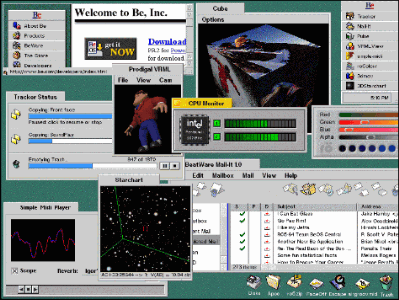
BeOS got its start on the BeBox which, from my perspective, was an extremely promising route to success. Finally, a machine designed and built from the ground up that would be affordable and bring the power and performance that many users had been looking for. A Super-PC that had multiple processors as standard equipment. It could have been like a modern day Amiga without the horrible marketing and limitations.
But Be ran into some problems. It looked for awhile that Apple might buy Be and integrate it into the Apple OS and many people, including myself, felt that this would be a great idea since System 8 is still behind the times technologically. But Apple pulled the plug on third-party licensing of the Apple hardware which really took a lot of steam out of Be's Macintosh plans. Be therefore made the decision to come over to Intel (which must have been quite a setback).
Most people take it for granted today but the PC, underneath the nice looking cases, is a complete mess from an operating system vendor's point of view. Hard core PC users get ticked off that their latest 3D card has crappy Windows drivers. That's only the tip of the iceberg. Try starting from scratch from a device driver standpoint. Imagine having to support all those wacko video cards, hard drive types, modems, sound cards, BIOS's, etc. What a complete nightmare it must be to try to support this! It's taken Linux and OS/2 years to provide adequate support and they have had extremely strong device driver support from developers (some may disagree but trust me on this, it takes a huge amount of work to even hope to keep up).
This trend to take hardware support for granted works in BeOS's favor at first because people forget about the bad old days. But a few days with BeOS will quickly bring reminders of those days. Given the Intel version isn't even out, except in developer release form, it's hardly fair to complain about this. Indeed, I'm not complaining, it's just a simple fact that if you take the BeOS route, be prepared to custom-make your PC to fit it, just as people did for NeXTStep for Intel before, and OS/2 before that.
But the look of BeOS is quite striking and definitely appeals to a number of people. On the other hand, looks alone should not make you switch OS's. [Evil Plug Alert] Stardock's own Object Desktop for Windows (in beta) can radically change the look and feel of Windows. Here's a screen shot of our BeOS theme (beta):
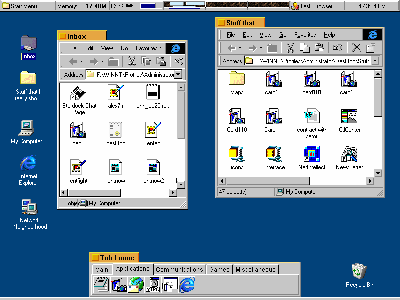
In the end, BeOS has a definite uphill battle to fight, and I am not sure it's going to make it. I really hope it does but having learned from my OS/2 experiences, software is what makes OSes successful. OS/2 had the added advantage of being demonstrably superior in a vast number of areas over Windows (user interface, multitasking, mulithreading, crash protection, 32-bit, cheaper, etc.). It had all those things going for it and yet did not become mainstream. Today, all operating systems have decent user interfaces, multitasking, crash protection (well, at least some), are 32-bit, etc. So what will BeOS do to carve out its niche?
I have a dream. This dream involves being able to simply purchase a couple of really, really powerful PC's and then let me hook them up to the network and allow fairly wimpy PC's connect to them and run applications off them where the application executes on the powerful PC but displays itself on the wimpy PC.
I'm in an office that is full of Pentium 75's. Many of these PC's are just used for doing general office work (data entry, word processing, email, technical support, etc.). But now, we're looking at having to upgrade these PC's as newer and newer versions of our applications seem to require ever more hardware to run decently. Who would have ever thought that an email package would bog down a Pentium? Stick with old software and get out of touch, go with new software and upgrade your machines.
But for me, Linux offers an alternative via X-Windows. Yes, X-Windows has been around for years and people still don't understand the promise it holds. Much of the JAVA fanaticism you see out there is misguided because these people basically just want to do what X-Windows has been doing for years. You know the typical conversation:
"You see, if we have an internal Intranet and a couple of servers running JAVA applications, then our thin clients, old PC's and such can connect to those servers and run the JAVA programs."
JAVA has some great strengths (which I'll get into in a different article) but what I think many corporations want to do is the same thing I want to do:
They want to have a couple of really powerful PC's that have the bread and butter applications running on them and a bunch of "thin" clients (read: older PC's that we're too cheap to upgrade) that can connect to them and run that software remotely. I'm writing this article on a Pentium 120, which was a pretty powerful machine once. But running Corel PhotoPaint on it today is extremely painful. Wouldn't it be great if I just had a P2-333 with 256 MB of RAM in the main lab that I could just hook up to and run Corel PhotoPaint on it but have it display on my machine? I'd get the speed (or pretty darn close) of the fast machine while being able to continue using my Pentium 120.
Recently, a company in Great Britain released a program called VNC which allows people to remote control other PC's. This is nothing new of course but the kicker is that it's free! Anyone who's used that program probably has the same hunger I do. Still, it's a fine program but not quite the same as X-windows which lets you seamlessly run programs that are on other PC's.
The problem with Linux is the same problem BeOS, OS/2, and other non-dominant operating systems have: applications. To the ultra-techie, the programs on Linux are fine, but for the majority of users, there's no alternative to PageMaker, or Corel PhotoPaint, or Corel Draw (the current version), or Office 97. Like it or not, people like these slick, bloated, feature-overkill applications and we're not going to do without them. We'll never use 90% of the features but, doggone it, we want them all there and we want the cute icons.
Linux is also a pain to install for casual users and adding hardware can be difficult. It's getting a lot better but it still has a ways to go.
Its user interface is also lacking. It's not bad but for many people, user interface is the key. For example, anyone using OS/2 today would probably name its user interface as the #1 reason why they're sticking with it.
Hardware support is also problematic. It's not bad, mind you but it's not 100%. When you buy something, odds are that the best-case scenario driver-wise is to scour the Internet for it. Smart Linux users will buy hardware with Linux in mind.
But Microsoft knows how to take advantage of this. You get your PC with Win95 or NT already on it, and that makes it a pretty tough case to convince someone to "upgrade" to Linux. Linux offers superior stability and vastly better performance, especially in multitasking, but to the average user, that's not enough and it's a problem that will get worse over time. You buy NT, it comes with a web server. We got in trouble with some of our users because our web site runs on NT. Why? Because we got a free copy of NT server and it was a 2-minute job to set it up and that meant that we could allow someone nontechnical to do it, leaving our precious developer/technical resources free to do other things. (The main reason though was because we had a PowerPC sitting around and it was either AIX, which we'd have to buy and learn, or NT, which we already had.)
But I think Linux's greatest strength is its ability to bring X-Windows to the masses. If there was a central marketing force for Linux, they could probably convince a lot of schools, a lot of companies, and a lot of government agencies to switch to Linux purely for the reasons I've mentioned. And this is happening to a degree already, just not as quickly or as widespread as it could be otherwise.
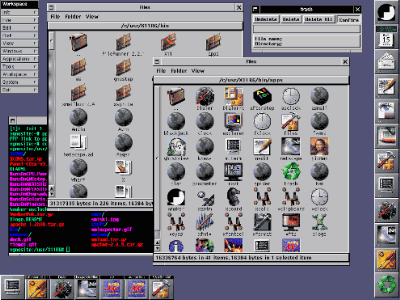
If you're not a Macintosh devotee, the Rhapsody/MacOS issue is pretty confusing. It essentially boils down to this: Steve Jobs talked Apple into buying NeXT instead of Be. So now Apple has this wonderful (if slightly long in the tooth) OS called NeXT that has Unix underpinnings on top of the Mach micro-kernel. It also has a well established (if not even more long in the tooth) OS called MacOS.
From a casual user perspective, MacOS is the best OS there is (as long as it comes with the Macintosh hardware). With that said, MacOS is still far behind technologically. I'm no fan of Windows 95 but saying Win95 = MacOS '89 is not only a bit conceited, it's just plain wrong. MacOS 6 (from circa 1989) did not have memory protection, had no real multitasking, no mulithreading, some pretty serious "init" issues, and was kind of ugly by today's standards. MacOS 8 improves much on this but not nearly enough. It's amazing how Apple just plain dropped the ball and allowed Microsoft to catch up.
For me, the strength of the MacOS has always been the vision of turning the PC into an appliance. People don't put a lot of thought into how their microwave oven works, they just know it works. Macintosh really was the computer for "the rest of us" (well, not me per se but for the general consumer). It is the computer that you buy, plug in, and it works like a simple appliance.
As time has gone on, Apple has moved further and further away from that. MacOS 8 is not nearly as simplistic as System 7 was and this is both good and bad. And Rhapsody is... well, it's powerful, but a far cry from the simplicity of the traditional MacOS.
Right now, it seems Apple's plan is to continue along with MacOS and slowly roll out Rhapsody as it matures. It's hard to say how compatible with traditional Macintosh applications Rhapsody will be, or how seamless that compatibility will be but Apple does have the third party support. For graphics designers, casual users, educators, and soon power users, the Macintosh/Rhapsody combo gives a pretty compelling story.
But over the long term, what will Apple be able to bring to the table that you can't already do with Windows? Gag I hate saying that but the Microsoft "rip off ideas, then implement them half-baked" approach to things seems to be working pretty well for them.
And it's hard to really advocate MacOS or even Rhapsody from an objective perspective if you're not already a Mac user. Linux holds out some unique promises, Be is at least different, but Rhapsody/MacOS are simply alternatives that are pretty comparable to Windows 98 and NT. This is good but the question will then just come down to market share, can Apple, armed with an Intel version of their OS, get their OS preloaded on machines? This will be the key.
Speaking of comparable alternatives, OS/2 is what happens if you fail to get pre-loads. OS/2's installed base of end users grew rapidly during the time frame when OS/2 was clearly superior. In 1992, 1993 and 1994, OS/2 was unquestionably a better OS. But when Windows 95 came out and when Windows NT improved to 4.0, the debate turned into an argument over technicalities. All the flame wars in the world over shortcuts versus shadows are not going to convince many people to give up all that Win32 software and jump over to OS/2.
Today, OS/2 is a viable alternative to Windows 95/NT but it gets tougher each year to give a good reason to switch when Windows 95 or NT came with your computer. It doesn't have the software support that MacOS has, it doesn't have X-Windows built into it like Linux, and it's not "hot and new" like Be. So OS/2 continues to be used by people who were already using OS/2.
And OS/2 does continue to thrive in corporate environments, largely because it can be run without a GUI and remain a 32-bit multitasking, multithreaded, protected operating system. IBM is trying to position OS/2 as the ultimate JAVA OS, though no one is sure to what end. IBM's strategy for network computing is relatively sound from a certain perspective but end users trying to stretch that strategy to fit their needs is not. There is no compelling reason to write a JAVA game. There is no compelling reason to write a large scale JAVA application. Sure, I could get a JAVA mail reader or news reader but to what end? How many people can't find a better native alternative? Am I going to buy a JAVA office suite when my computer probably came with Microsoft Office? Even if it didn't come bundled with Office 97, would I go with a slower, feature-poorer office suite?
With this in mind, what is IBM hoping to do with OS/2? Their plan is largely to create a plethora of JAVA applets that allow information to be handed around easier. Intranets running JAVA applications that allow clients to do their data entry more easily. Or JAVA applets that allow remote users to easily access needed data. This is all well and good but why OS/2 then? Sure, the benchmarks show it runs JAVA faster, but in reality does anyone notice?
Ironically, IBM has largely given up on the parts of OS/2 that really could have made OS/2 grow in more market segments -- object oriented technology. They could have continued forward with DSOM and integrated OS/2 truly into the Internet. Not in some half baked way like Microsoft's "active desktop" but by making the Workplace Shell truly Internet/intranet aware. They could have also made it so that OS/2 could remotely execute programs à la Linux. Workspace on Demand has some of this but it's not enough, and IBM continues to market it to only certain segments. The problem with OS/2 at IBM is that IBM isn't sure what exactly to do with it.
If you're already an OS/2 user, there's not a lot of reason to move away from it at this point. OS/2 continues to get pretty good hardware support, application support is still there, from Lotus for example, who just released a new version of SmartSuite for OS/2. Where OS/2 does suffer is in grassroots development support. One developer I talked to said, "OS/2 users are takers. They cry 'gimme, gimme, gimme', but never do anything to give back." Upon reflection, this is true of certain parts of the community. Many OS/2 users only try out freeware but they themselves aren't willing to give a stab at trying to contribute anything back to the "community" (i.e. lots of freeware users but few freeware developers). This is in stark contrast to the Linux and BeOS communities that are jumping over themselves to write software for free for the OS. Nowhere is the problem more visible than in the VNC porting. As mentioned earlier, VNC is a free remote control package that runs on several OSes. The source code is freely available and already there's versions for Linux, Mac (I think), Windows 95/NT and even a BeOS port on the way. But where's the OS/2 version?
That's not to say that there's nothing going on in terms of grassroots development. The Win32-OS/2 project is succeeding beyond anyone's expectations -- it's a program in which you simply run a converter on a Win32 executable or DLL and it converts it to an OS/2 EXE or DLL without even a significant performance loss. Truly amazing. When our company came out with a Map Creation utility for our game Entrepreneur, we only had a Win32 version. But an OS/2 user managed to use the Win32 converter on it and turned it into an OS/2 converter. That's amazing. Naturally there's been no mention in the press since the press, which now lamely complains about Microsoft's dominance in the OS market, still shuns any discussion of OS/2.
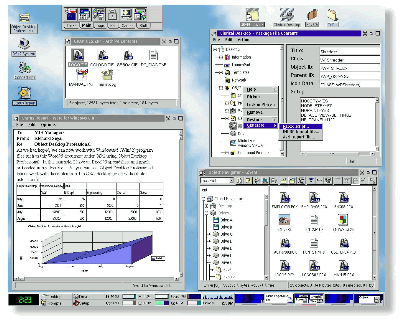
Despite OS/2's problems, I can't help but wonder exactly why someone would use an OS such as BeOS over OS/2. It has to be a perception issue. In fact, I asked a group of BeOS users this very question and they said that the difference is that they feel like IBM doesn't care about OS/2 and that it's stagnating while BeOS is up-and-coming.
IBM is certainly not the master of end-user perception but in reality, OS/2 continues to get updates on a regular basis. There have been 6 significant updates to OS/2 just in the past year. While many BeOS users may not agree, I just can't see why they don't use OS/2. It's already a powerful multitasking mulithreaded OS with a great user interface, pretty decent software application support, and good device driver support. I think in the end, OS/2's biggest problem is perception and that is what is holding it down.
One can't mention perception affecting reality without talking about Windows 95. Microsoft is the king of making a good first impression. On the surface, Windows 95 has plug and play, its shortcuts allow for an almost object-oriented working of the system, it has a registry for keeping good track of your programs, and it is just plain slick.
I don't want to make it sound like Windows 95 is junk -- it's not. As an engineer, I just hate seeing inferior technology win. Windows 95 isn't bad but it's a far cry from being the best choice out there strictly from a quality standpoint. As you run Windows, you tend to discover that the registry gets into trouble and the system becomes less and less stable. Programs can hang the system, causing you to have to reboot.
But overall, Windows 95 works and does the job adequately and key preloads have ensured that it, and Windows 98, will be the dominant OS. Indeed, the OS Wars could be considered over with all that are left being bandits in the hill sniping at Windows 95 and NT.
Windows 95 may have dealt the deciding blows to the competitive OSes but it's Windows NT that benefits. After its disappointing start with Windows NT 3.1, NT continued to steadily improve. NT 3.5 was quite decent if you could ignore the user interface and NT 4.0 has become the mainstream choice of power users. People who dislike Microsoft will often slam NT for its problems; problems that do exist, but that frankly don't really affect most people. NTFS has problems with fragmenting, for instance. But how much does this affect the average user? Hardly at all. NTFS also has the ability to seamlessly compress directories which is pretty nice. Microsoft, always looking to eliminate competition, has also ensured that it comes bundled with pretty much everything. The microwave oven and stereo that NT 4.0 came with, while now in my kitchen and living room respectively, are arguably meant to be part of the OS and those who disagree are just sorry losers who obviously just envy Microsoft.
But NT disappoints me and here's why: Microsoft has succeeded in ripping off good ideas but they continually implement them half-baked and now, most professional PC users are stuck with a Microsoft solution. But cool features like the ones I mentioned in Linux or in OS/2 are just not there in NT. Microsoft just implements the easy-to-see features. They clone much of OS/2's Desktop for their GUI (sorry Mac users, it was OS/2 that Win95's UI was largely based on, not MacOS -- of course, OS/2's Desktop was derived much from the Mac, but there are a lot of key differences) but Microsoft only implements it halfway and so much of the elegance of OS/2's Workplace Shell is lost in NT.
Also NT tries to claim to be "multiuser". However, without an X-Windows type system integrated into NT, NT is not multiuser in the traditional sense.
NT's multitasking also leaves a lot to be desired. Processor intensive apps, particularly Win16 ones, can really bog down the system's responsiveness unless you manually change the process's priority (and how many people know how to do that?). On OS/2, I used to do a lot of rendering in the background and never even noticed the impact of it. On NT, the system gets quite sluggish and it still takes it just as long to finish the rendering.
But NT is very solid and rarely crashes in its normal use. Given that Windows 98 is going to be the last of the "regular" Windows line, for most people, Windows NT is the future of the PC OS.
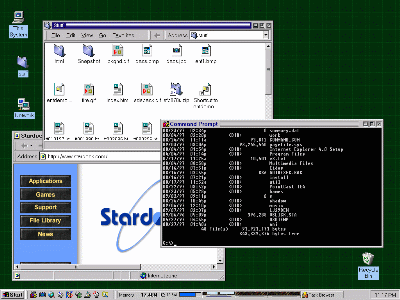
I read a recent article in one of the trade magazines where the author felt that now was the time to create an alternative OS to what's out there, that Windows 95 and NT had too many flaws and was ripe for some good competition. The new OS would just need to avoid the "mistakes" IBM, Be, and Apple have made such as lack of apps, bad driver support, and an unclear marketing message.
I couldn't help but think, "Well DUH!" Like those companies weren't aware of those problems. As if some new company could just wave a magic wand and not make these "mistakes". Kind of ironic for a columnist in a weekly trade magazine to complain about lack of choice after they spent years deriding non-Windows OSes for pretty suspect reasons. The lack of foresight by many in the media has lead to an industry where the magazines are now getting thinner and thinner (how thick are the weekly trade magazines these days, for instance?). Those who have spent much of their time advocating AmigaDOS or MacOS or OS/2 or Linux or BeOS can at least see the irony that those same magazines that spent just as much effort trying to ensure that it is a Windows world, sowed their own destruction (or at least their own downsizing).
So the war has pretty much ended, the remnants of the rebel forces have taken to the hills and prepare for the future when the dominant OS is ripe for attack again. And while Windows 95 and NT are far from being the ideal OSes we'd like them to be, they're not too horrible.
But the alternative OS's are so much better now than they used to be that you really don't lose out by trying out Linux or OS/2 or BeOS or MacOS (if you can afford it).
Resources:
Brad Wardell is the founder and President of Stardock Systems, one of the leading developers and publishers of OS/2 business and leisure software.
| Copyright © 1998 - Falcon Networking | ISSN 1203-5696 |